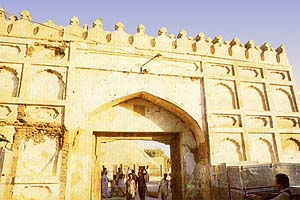Founded in 1768 on the site of the ancient town of Nirun-Kot by Ghulam Shah Kalhora, the saintly ruler of Sind, it was named after the prophet Mohammed's son-in-law, Ali, also known as Haidar. It remained the capital of Sind under the Talpur rulers who succeeded the Kalhoras till 1843 when, after the nearby battles of Miani and Dabo, it surrendered to the British, the capital was then transferred to Karachi.
Incorporated as a municipality in 1853, it is an important commercial
and industrial center. Its economic activities include textile,
sugar, cement, and hosiery mills, manufacturing of glass, soap, ice,
paper, and plastics. There are hide tanneries and sawmills.
Ornamented silks, silver-work, gold-work and lacquerware are also
some of its exclusive products. Noteworthy antiquities include the
tombs of the Kalhora and Talpur ruler, palaces of the former amirs
of Sind.
 Newly developed settlements and industrial estates surround the congested old city area. An
noteworthy characteristic of this city is, badgirs (wind-catchers)
fixed to housetops to catch sea breezes during the hot summer
season. A hospital, municipal gardens, zoo, sports stadium, and
several literary societies are in the city. The University of Sind
with 32 affiliated colleges was founded in 1947 in Karachi and moved
to Hyderabad in 1951, where it lies across the Indus. Other
education needs are served by numerous government colleges, the
Liaquat Medical College and specialized vocational institutions.
Newly developed settlements and industrial estates surround the congested old city area. An
noteworthy characteristic of this city is, badgirs (wind-catchers)
fixed to housetops to catch sea breezes during the hot summer
season. A hospital, municipal gardens, zoo, sports stadium, and
several literary societies are in the city. The University of Sind
with 32 affiliated colleges was founded in 1947 in Karachi and moved
to Hyderabad in 1951, where it lies across the Indus. Other
education needs are served by numerous government colleges, the
Liaquat Medical College and specialized vocational institutions.


